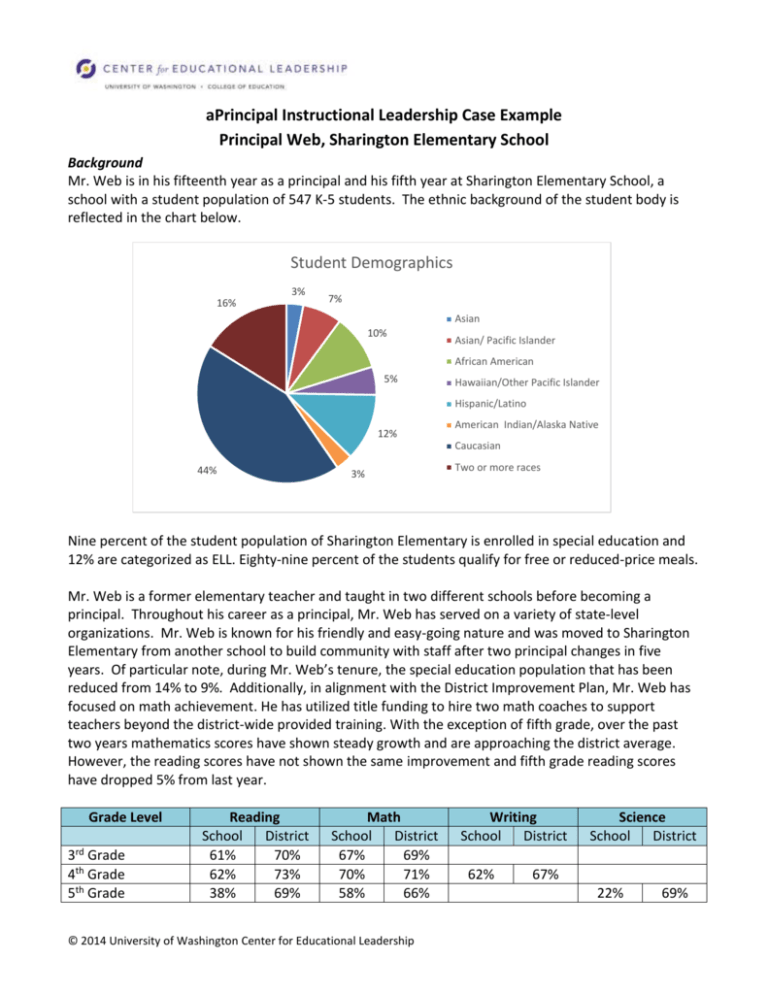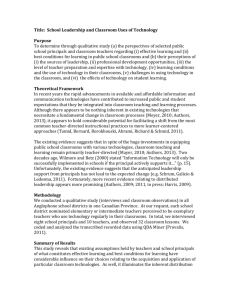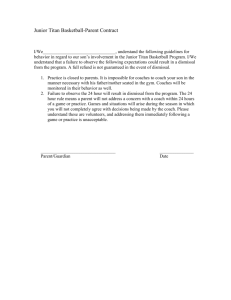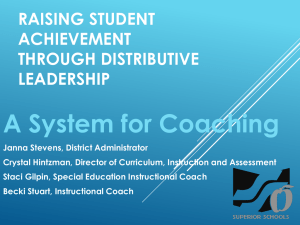AP study
advertisement

aPrincipal Instructional Leadership Case Example Principal Web, Sharington Elementary School Background Mr. Web is in his fifteenth year as a principal and his fifth year at Sharington Elementary School, a school with a student population of 547 K-5 students. The ethnic background of the student body is reflected in the chart below. Student Demographics 3% 16% 7% Asian 10% Asian/ Pacific Islander African American 5% Hawaiian/Other Pacific Islander Hispanic/Latino 12% American Indian/Alaska Native Caucasian 44% 3% Two or more races Nine percent of the student population of Sharington Elementary is enrolled in special education and 12% are categorized as ELL. Eighty-nine percent of the students qualify for free or reduced-price meals. Mr. Web is a former elementary teacher and taught in two different schools before becoming a principal. Throughout his career as a principal, Mr. Web has served on a variety of state-level organizations. Mr. Web is known for his friendly and easy-going nature and was moved to Sharington Elementary from another school to build community with staff after two principal changes in five years. Of particular note, during Mr. Web’s tenure, the special education population that has been reduced from 14% to 9%. Additionally, in alignment with the District Improvement Plan, Mr. Web has focused on math achievement. He has utilized title funding to hire two math coaches to support teachers beyond the district-wide provided training. With the exception of fifth grade, over the past two years mathematics scores have shown steady growth and are approaching the district average. However, the reading scores have not shown the same improvement and fifth grade reading scores have dropped 5% from last year. Grade Level 3rd Grade 4th Grade 5th Grade Reading School District 61% 70% 62% 73% 38% 69% Math School District 67% 69% 70% 71% 58% 66% © 2014 University of Washington Center for Educational Leadership Writing School District 62% Science School District 67% 22% 69% Meeting 1: Mid-August It is your second year as a principal supervisor. These notes are from an initial summer meeting you scheduled with Mr. Web to initiate and preview how you will work with principals during the school year. A committee of principals and principal supervisors met during the summer to review and revise the evaluation roadmap for the year as well as the initial data points for goal setting. You previously sent out an email outlining the roadmap and the data points all principals were asked to review prior to their goal setting conference in October. Accompanying that email was a schedule of visits to each school for an initial meeting, a walkthrough, and a goal setting meeting. Your focus for the initial meeting was to discuss each principal’s agenda for the teacher professional development days prior to the beginning of the school year. Additionally, it was to review the student data and the evidence of teaching practice that you asked principals to analyze in preparation for the upcoming goal setting conferences. You also wanted to answer any questions that principals may have based on the revisions the committee had made over the summer. Mr. Web was waiting in his office when you arrived at the school at the scheduled meeting time. Mr. Web jumped up and met you at the door and introduced you to his new assistant secretary. He then walked you to his counselor’s office to meet the new intern. On the way back to his office, he stopped in the principal assistant’s office to say hello and offered to have the principal assistant join for the meeting. You reminded Mr. Web that this was a time set up to meet with him individually and communicate about goal setting and your work together for the year. You stated that you will be happy to set up a time with the principal and the principal assistant at another time. Mr. Web thought that was a great idea and would love for you to be a part of the principal assistant’s goal setting conference. You shared with Mr. Web the purpose of your visit and referenced your email. Mr. Web nodded that he knew why you were meeting and pulled out a folder with the email and a completed principal leadership self-assessment. You did not take the copy of the self-assessment but noticed the prior year’s date on the corner. Mr. Web also had a folder of state assessment data. He let you know he had already met with his math coaches and they had thoroughly analyzed the results. You complemented Mr. Web on the school’s good work in math, but reminded him that you will be meeting at a later date to discuss and analyze the data points you would use for goal setting. You asked him if he had his agenda for the teacher professional learning days, and if he had any questions about what you were asking him to prepare for the goal setting conference or the process itself. Mr. Web said that he felt like he is ready for the goal-setting meeting but if you have anything in addition you would like him to do, he would be happy to do so. He also stated that the math coaches are still working on the agenda for the professional development days and it is not yet completed. You responded by reminding Mr. Web that you had asked principals to have this agenda completed for discussion at this meeting. You also added that his staff will be looking for this agenda as the training is coming up soon. You also asked Mr. Web when he will be meeting with his coaches to finalize the agenda and inquired as to whether there is input from staff or the leadership team on the agenda. He said that he listened to what the staff wants and their voice is heard on the agenda. He stated that the leadership team will vet the agenda as well. You asked about the date of this meeting and he let you 2 know he has to check with the coaches and he will get back to you. Since the agenda was not yet ready, Mr. Web asked you to join the meeting. Meeting 2: 3rd Week of August This meeting is a follow-up at the request of the principal and due to the late teacher professional learning day agenda. Upon arrival at the school, the office staff directed you to the title office for the meeting. There was a table with breakfast items and coffee as well as a table for the meeting. The Leadership Team was eating and discussing their summer vacation. Mr. Web jumped up and welcomed you to the meeting and informs you that they are doing some team building before the meeting gets started. After fifteen minutes the team, comprised of one primary teacher, one intermediate teacher, two math coaches, one literacy coach, the principal assistant, and the principal, get started on creating the agenda. One of the math coaches facilitated the meeting and the other math coach charted the agenda items. Whenever the team asked the principal for his thinking he told the team that the agenda was theirs. He also frequently deferred to you and asked, “What do you want?” or, “What does the district want?” At the end of the meeting, the agenda was completed and contained one-and-a-half days dedicated to math data analysis and training, and half day dedicated to ELA data analysis and training. Meeting 3: 4th Week of School These notes are from a three-hour visit you had with Mr. Web. Prior to this round of visits with all your principals, you sent an e-mail indicating that during the September and October walkthroughs, principals should pick the 3-5 classrooms that they felt showed the range of instructional practice in the school. In addition, you asked principals to select a content area that was an area of focus for student growth based on current data and in their School Improvement Plan. Finally, each principal was asked to provide a copy of observation feedback from the prior year for three of the teachers observed representing a basic, proficient and distinguished summative score overall. Mr. Web was in his office visiting with a math coach when you arrived. He greeted you and told you he was just checking with the math coach on the choices he had made for the walkthrough. The math coach left the office and you sat down to pre-brief with the principal. Mr. Web had selected two third grade teachers, two fourth grade teachers, and one fifth grade teacher for the walkthrough. The area of focus was math. After the “look fors” and the student questions were established, Mr. Web took you to the classrooms for 15 minutes each. You observed math instruction in four classrooms. In one of the third grade classrooms, a math coach was modeling a lesson for the teacher as she took notes. While in the classrooms, Mr. Web was very comfortable talking with students and asking questions. However, he did not take many notes. His questions for students also tended to stray from the agreed-upon walkthrough questions. As you entered the final classroom, a fifth grade class, Mr. Web was very surprised to see ELA instruction. Some students were sitting on the floor for a mini-lesson but six were in their desks. All students had the same novel. The teacher told the students that they should read along as he read aloud. They should stop him from reading when they recognized a section of text that provided a clue about the character traits of each character. He started reading the first sentence and a student 3 shouted out for him to stop. He asked the student what she had noticed about character traits and she said that she knew something about the setting and wondered if he wanted them to notice that as well. The teacher said he did not want that and continued to read. Most students on the carpet appeared to follow along with the text and one student at his seat followed along. Six students stopped him during the next 10 minutes and two of the students could connect the text to a character trait of one of the book’s characters. After the walkthrough, you debriefed with Mr. Web the noticings from each class and asked him about his wonderings for each of the classrooms. In the debrief Mr. Web indicated strengths for each teacher but really could not formulate wonderings that he might have for each teacher. He said things like: “I noticed Mr. A had students working in groups and I wonder if that is working out. I noticed Mrs. H is using the new math manipulatives the district purchased and I wonder if the kids like those materials. I noticed the students in Mrs. D’s class were asking each other to defend their thinking. I wonder what she plans to do next?” When you transitioned to the fifth grade classroom, Mr. Web said that he was surprised that Mr. K was teaching ELA. However, students seemed really excited about the book they were reading. He noticed that two students could identify text that supported character traits and wondered why only two could do it. He did note that the reading scores from the previous year’s fifth grade class had not been strong. After debriefing the classrooms, you confirmed with Mr. Web his timeline for feedback to the teachers on the walkthrough and reminded him to forward the communication to you. The two of you then turned your attention to the observation feedback he had selected. He had two fourth grade teachers that he said represented distinguished, and he had a third grade teacher that represented proficient. He said that he did not have a basic teacher in the group just visited. You asked about the fifth grade teacher you had just observed, and he said that this teacher was also proficient. As the two of you reviewed the observation feedback, you noticed that Mr. Web as able to identify evidence aligned to the teaching framework. But suggestions for next steps were not aligned to the evidence or in some cases the criterion. Other Evidence: In your work with Mr. Web to this point and in reviewing files you have collected this additional data: All of Mr. Web’s teachers have received a proficient or distinguished on their evaluation in past year. The feedback that Mr. Web sent to his staff regarding the supervisory walkthrough in September had noticings aligned to the math content but omitted any information about the ELA content. Mr. Web included your name in the wonderings for the staff to consider. The School Improvement Plan does not include an ELA goal and the October Developmental Reading Assessment scores for fifth grade seem to lack alignment to the fourth grade state reading results for the same cohort. Grade Level DRA - % of students at standard or above 1st Grade 2nd Grade 3rd Grade 4th Grade 5th Grade 48% 46% 51% 58% 37% 4 5







